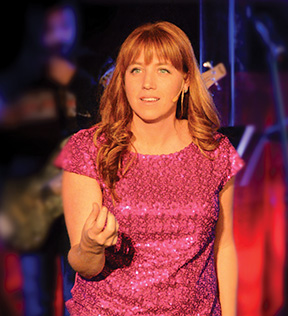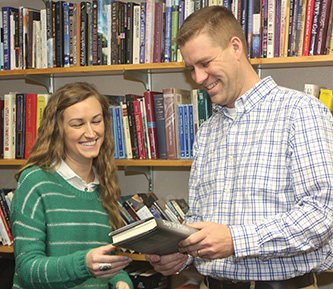After all, in 1 Timothy 2:12, Paul says, “I do not permit a woman to teach or to assume authority over a man.” Are we (I use we because I am president of OCC) simply disregarding this text from God’s Word? If we are a true Bible college—teaching what the Bible teaches, prohibiting what the Bible prohibits, and allowing what the Bible allows—then what possible scriptural warrant is there for a women’s preaching class?
To answer that question, let me tell you a story.
Ten years ago, the OCC faculty used its weekly faculty meetings for an entire semester to study the biblical teaching on women’s roles in the church. Together we surveyed Scripture and exegeted the key New Testament passages. Our goal was to set political correctness and cultural pressures aside and to simply let God’s Word have its say on this important subject.
We wanted to follow wise hermeneutical principles in our study. We employed the principle of harmony, which reminded us not to interpret any text in isolation. Rather, we sought to interpret each particular Scripture in light of all of Scripture. God’s Word does not contradict itself, so we sought to harmonize the Bible’s teachings.
Our journey was also guided by the principle of history, which reminded us that God’s eternal commands were communicated in specific historical contexts. A text cannot mean what it never meant, so we sought to hear the Bible’s words as the first readers would have. As we understood the original historical-grammatical context, we would understand the Word of God.
Finally, we wanted to follow the principle of humility. This principle simply reminded us that, while God’s Word is absolutely authoritative, my particular interpretation of it is not. We are fallible human beings, and we are wise to at least entertain the possibility that our understanding of Scripture might be wrong. We must allow for our minds to be changed if our study of the Bible leads us to a different place than where we started. This is true submission to God.
So What Does the Rest of the Bible Actually Say?
With those guidelines in place, Ozark faculty members began their exegetical journey. We wanted to obey 1 Timothy 2:12. But to understand what it was (and wasn’t) saying, we needed to look at the rest of Scripture’s teaching on women’s leadership.
![03_Proctor_JN]() In the Old Testament, primary leadership of God’s people was reserved for men. All the priests were men; every published prophet was a man. However, on occasion, women did have a leadership role among God’s people. Women, such as Miriam (Exodus 15:20, 21) and the ladies in the choir (1 Chronicles 25:5, 6; Ezra 2:65; Nehemiah 7:67) helped lead worship. Deborah served as both a judge and a prophetess (Judges 4:4). Miriam, Huldah (2 Kings 22:14), and Isaiah’s wife (Isaiah 8:3) were also called prophetesses.
In the Old Testament, primary leadership of God’s people was reserved for men. All the priests were men; every published prophet was a man. However, on occasion, women did have a leadership role among God’s people. Women, such as Miriam (Exodus 15:20, 21) and the ladies in the choir (1 Chronicles 25:5, 6; Ezra 2:65; Nehemiah 7:67) helped lead worship. Deborah served as both a judge and a prophetess (Judges 4:4). Miriam, Huldah (2 Kings 22:14), and Isaiah’s wife (Isaiah 8:3) were also called prophetesses.
How about in the New Testament? In the Bible’s last 27 books, it again seemed clear that men were the primary leaders of God’s people. All 12 apostles were men; church elders were described as men. In fact, 1 Timothy 2:12, 13 grounded this in the doctrine of creation itself. Adam was formed first, says Paul, as God’s way of hard-wiring male leadership into his created order.
The New Testament often showed us women involved in nonleadership works of service—Martha feeding Jesus and his disciples (Luke 10:40), Tabitha (Dorcas) making coats for widows (Acts 9:39), Nympha hosting a church in her home (Colossians 4:15). One wag noted that if the wise men of Matthew 2 had instead been wise women, they would have asked directions, arrived on time, helped deliver the baby, cleaned the stable, made a casserole, and brought practical gifts like diapers! This much was certain: like the Mary mentioned in Romans 16:6, women “worked very hard” in the church’s behind-the-scenes labors.
But we also saw women’s gifts deployed in occasional proclamation and ministry leadership roles. After Jesus’ resurrection, God chose women to be the first bearers of the Easter message, as Mary and Mary Magdalene announced it to the apostles (Matthew 28:1, 7). Anna was called a prophetess (Luke 2:36), as were Philip’s four daughters (Acts 21:8, 9). Phoebe was called a deacon (Romans 16:1), and Romans 16:7 seemed to call Junia an “apostle”—in the broader, general sense of “missionary” or “one sent out” like Barnabas (Acts 14:14) and Epaphroditus (Philippians 2:25). Priscilla, with her husband Aquila, taught Apollos privately (Acts 18:26), and we heard Paul saying that Euodia and Syntyche somehow “contended at my side in the cause of the gospel” (Philippians 4:2, 3).
So far, then, the Bible seemed to be painting a picture of ongoing, regular male leadership—sprinkled with rarer moments of occasional female leadership—among God’s people.
An Often Overlooked Text
But as our faculty study continued, the question remained: what about women preaching? Doesn’t 1 Timothy 2:12 say that a woman is not to teach a man? Clearly a woman may teach a man in private, as Priscilla did with Apollos, so 1 Timothy 2:12 must instead mean that a woman may not teach a man publicly in the church assembly, right?
It is certainly true that 1 Timothy 2 is about the public worship service. However, an often-overlooked text clarified our understanding of that passage.
In 1 Corinthians 11:5, Paul tells us that women prophesied in the New Testament church’s worship assembly. Important note: as you may know, prophesying in Scripture was more proclamation than prediction. While it might include foretelling, more often prophesying meant forthtelling God’s message to God’s people.1 In other words, it was much like what we call preaching today.
First Corinthians 11 was telling us that, in the first-century culture, a woman who prophesied in church should keep her head covered, indicating an attitude of submission to the church’s male leaders. The implication was clear: a woman is allowed, in a posture of humble followership, to prophesy in the church’s assembly. She can share a message from God, even with the men present.
Since the Bible doesn’t contradict itself, this understanding of 1 Corinthians 11 led us as a faculty to believe that, whatever 1 Timothy 2 was teaching, it must not be teaching that women can never on any occasion speak or proclaim God’s message in church. Otherwise Paul would be prohibiting in the 1 Timothy text what he allows in the 1 Corinthians 11 text.2
By the way, we couldn’t help thinking of the Day of Pentecost. What text did Peter use for the very first Christian sermon? He quoted Joel 2 to talk about the Spirit’s new indwelling presence among Christ’s followers, “In the last days, God says, I will pour out my Spirit on all people. Your sons and daughters will prophesy” (Acts 2:17).
But if the church’s daughters can prophesy/preach, then what exactly was Paul prohibiting in 1 Timothy 2:12?
A Critical Clue in the Grammar
At this point, we as a faculty moved from the principle of harmony (what does the rest of the Bible say?) to the principle of history (how would the original readers have understood this?).
I once had a preaching professor who said that Greek in a sermon should be like underwear: it should provide good support but you shouldn’t let it show! Pardon me for letting some Greek show, but it’s important because God communicated his eternal truth in normal human grammar that can be analyzed and comprehended. Understanding the biblical grammar helps us understand the biblical God. So hang with me here.
The original readers of 1 Timothy, of course, spoke Greek, and when Paul wrote 1 Timothy 2:12, he chose a very specific Greek grammatical construction. The phrase “to teach” (didaskein in Greek) is a present tense infinitive instead of an aorist tense infinitive.3 The aorist tense is a close-up photographic snapshot of an action, picturing as little as one particular occurrence. The present tense is a wide-angle movie camera shot of an action, picturing a continuous, habitual, ongoing condition—a state of being.
For example, “to believe” (aorist) means to exercise faith on a given occasion, while “to believe” (present) means to be a believer. “To serve” (aorist) means to perform an act of service, while “to serve” (present) means to be a servant. “To sin” (aorist) means to commit a particular sin, while “to sin” (present) means to be a sinner.4
So “to teach” (aorist) means to teach on a given occasion, while “to teach” (present) means to be a teacher. When Paul says in 1 Timothy 2:12 that he does not permit a woman “to teach” (present), he is not saying she can never teach on any given occasion in church. Instead, he is saying that a woman should not be the continuous, ongoing, habitual teacher. That’s the implication of the Greek grammar, and it’s reasonable to believe this is how the original readers would’ve understood it.
A Conclusion to Our Exegetical Journey
This raised a question: who are the continuous, ongoing, habitual teachers for the congregation? The answer is in the immediately following context of 1 Timothy. Just a few verses later, Paul tells us that the elders are the teachers. (Elders are men “able to teach” in 1 Timothy 3:2.) They are the recognized, authoritative, the-buck-stops-here teachers. So from the context, it would seem that when Paul says he “does not allow a woman to teach or have authority over a man,” he is saying that he does not allow women to be elders.
By the way, the description in the New Testament that best fits what we call the “preacher” of a church is the elder who is paid to preach and teach (1 Timothy 5:17). So if a modern-day “preacher” is a preaching-teaching elder, then it would seem that 1 Timothy 2:12 prohibits women from being the preacher of a local congregation.
All of this certainly squared with our survey of the Old Testament: ongoing, regular male leadership—sprinkled with rarer moments of occasional female leadership—among God’s people. So as a faculty, after our study of Scripture, we came to these conclusions:
1. Beginning with creation, God has hard-wired male spiritual leadership into the system, and God is calling men to step up as the primary leaders in his church.
2. The regular teachers and leaders in any congregation, then, are to be the elders—a role reserved for men. This includes the role of “the preacher” in a local church.
3. The New Testament does also allow for women, on occasion, to preach and teach in church—from a posture of submission to the elders’ ultimate authority.
Don’t Miss the Most Important Fact
As a college under the authority of Scripture, we want to prohibit what the Bible prohibits and allow what the Bible allows. So, yes, in our curriculum at Ozark Christian College, we have a preaching class for women—but not because we believe women should be the preacher of a local church. Rather, it’s because we believe that when women have opportunity to preach and teach on occasion (as the Bible seems to allow), they should be prepared to do their best for God’s glory and the church’s good.
In all the talk about women preaching, don’t miss this important fact: women are also gifted and called to serve in many significant ways in the church’s life that are not “up-front” ministry. These should be honored and celebrated, because God-given gender roles are not meant to be competitive but complementary. We’re all wearing the same jersey, and God never intended to leave the female half of his team sitting on the bench. He wants them in the game because we have a world to win.
As Jesus said, “The harvest is plentiful but the workers are few” (Matthew 9:37). The evangelistic need is so great that the Lord calls all hands on deck, ready to work, without squabbling about who gets to do what. Let’s equip every available person—man and woman—in every biblically possible way to share the good news with a lost world. I think Kay Moll put it best when she said, “I am not so concerned about the role of women as I am the cause of Christ.”
________
1“Less than 2 percent of Old Testament prophecy is messianic. Less than 5 percent specifically describes the New Covenant age. Less than 1 percent concerns (end times) events.” Gordon Fee and Douglas Stuart, How to Read the Bible for All It’s Worth (Grand Rapids: Zondervan, 1981), 150.
2In 1 Corinthians 14:34, Paul says, “Women should remain silent in the churches.” But just a few chapters before, in 1 Corinthians 11, he had clearly made allowance for women to prophesy in church! Is he contradicting himself? No. The context of 1 Corinthians 14 would indicate he is excluding women from the authoritative teaching function of weighing prophecy in the assembly, not excluding them from uttering prophecy in the assembly. Weighing prophecy, it would seem, is likely reserved for the elders . . . who, as we shall see, are to be men. See D.A. Carson’s chapter in Recovering Biblical Manhood and Womanhood: A Response to Evangelical Feminism, eds. John Piper and Wayne Grudem (Wheaton: Crossway, 1991).
3“To have authority” in 1 Timothy 2:12 is also a present tense infinitive.
4Kenneth Wuest, The Pastoral Epistles in the Greek New Testament (Grand Rapids: Eerdmans, 1958), 48.
Matt Proctor is president of Ozark Christian College, Joplin, Missouri, and a CHRISTIAN STANDARD contributing editor.
________
‘Humility: The Bookends of Bible Study’
Alexander Campbell taught that a Bible student can come within “understanding distance” of God’s Word—Scripture’s meaning really can be grasped—but that no one stands perfectly in the center of that “circle of understanding” except God himself. None of us is an infallible interpreter. All of us must practice the hermeneutical principle of humility.
Mark Scott, former academic dean at Ozark Christian College, put it this way, “Humility bookends the hermeneutical task.” We begin and end our study in humility. That’s why we constantly revisit our exegesis and thinking. That’s why we never give in to the belief that we have hermeneutically “arrived,” and that’s why Scott once said, “In all my years of studying the Bible, I cannot remember a year that I did not, at some point, say, ‘I guess I was wrong about that.’”
As a college faculty, our exegetical journey led us to an understanding that seemed faithful to all the biblical texts. However, we knew that other intelligent, orthodox, Jesus-loving, Bible-believing Christians had come to different conclusions. This gave us an opportunity to practice a core Restoration Movement principle: “In essentials, unity; in nonessentials, liberty; in all things, love.”
While important, women’s roles in the church did not seem to be an essential of the faith. Since it was not a test of salvation, it would not become a test of fellowship. We would not label as liberals those who understood the Bible more permissively. Nor would we label as legalists those who saw women’s roles more prohibitively.
Instead, we would listen to those who disagreed with us to see if our understanding could be improved. We would practice the principle of humility, and we would “in all things” love and respect our brothers and sisters in Christ.
—M.P.




















